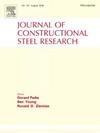Experimental Investigations on Structural Behaviour of Reusable Interlocking Steel column base Connection with Demountability
IF 4
2区 工程技术
Q1 CONSTRUCTION & BUILDING TECHNOLOGY
引用次数: 0
Abstract
Implementing a circular economy in construction is one of the potential approaches to limit the natural resource consumption by the construction industry and construction waste generation after demolition. There exist necessities for constructing buildings with easier demountability and direct reusability. One of the key aspects of reuse is designing with structural connections for demountability after service life, rendering the buildings for reuse. Therefore, this study endeavours to develop a directly reusable interlocking hold-down type column base connection for steel structures through full-scale experimental and theoretical investigations. The new reusable column base connection consists of a connector plate to replace the anchor rods in the traditional exposed column base connections to connect the concrete footing with the steel column and base plate assembly. This paper investigates the structural behaviour of the new reusable column base connection subjected to monotonic lateral loading and determines the effective embedment depth required for the connector to avoid concrete failure. A loading protocol that signifies reuse through repeated loading sequences is adopted for this study. Thus, each specimen is loaded for three repeated reuse cycles. A theoretical method based on the traditional component model concept representing the connection components as a combination of spring assembly is developed to predict the initial elastic stiffness of the connection. This will consequently aid in estimating the lateral displacement occurring for the corresponding design load. The theoretically predicted stiffness values are in good correlation with the experimental results. The design example for stiffness calculation is also provided for industrial practical applicability.
具有可拆卸性的可重复使用联锁钢柱底座连接结构行为的实验研究
在建筑业中实施循环经济是限制建筑业自然资源消耗和拆除后产生建筑垃圾的潜在方法之一。有必要建造便于拆卸和可直接重复使用的建筑。重复使用的一个关键方面是设计结构连接,使建筑物在使用寿命结束后可拆卸,从而实现重复使用。因此,本研究致力于通过全尺寸实验和理论研究,为钢结构开发一种可直接重复使用的联锁压紧式柱基连接。这种新型可重复使用的柱基连接由一个连接板组成,用来取代传统外露柱基连接中的锚杆,将混凝土基脚与钢柱和底板组件连接起来。本文研究了新型可重复使用柱基连接在单调侧向荷载作用下的结构行为,并确定了连接器为避免混凝土破坏所需的有效埋入深度。本研究采用了通过重复加载序列表示重复使用的加载协议。因此,每个试样要重复加载三个重复使用周期。研究开发了一种基于传统构件模型概念的理论方法,将连接构件表示为弹簧组件的组合,以预测连接的初始弹性刚度。这将有助于估算相应设计荷载下发生的横向位移。理论预测的刚度值与实验结果具有良好的相关性。此外,还提供了刚度计算的设计实例,供工业实际应用。
本文章由计算机程序翻译,如有差异,请以英文原文为准。
求助全文
约1分钟内获得全文
求助全文
来源期刊

Journal of Constructional Steel Research
工程技术-工程:土木
CiteScore
7.90
自引率
19.50%
发文量
550
审稿时长
46 days
期刊介绍:
The Journal of Constructional Steel Research provides an international forum for the presentation and discussion of the latest developments in structural steel research and their applications. It is aimed not only at researchers but also at those likely to be most affected by research results, i.e. designers and fabricators. Original papers of a high standard dealing with all aspects of steel research including theoretical and experimental research on elements, assemblages, connection and material properties are considered for publication.
 求助内容:
求助内容: 应助结果提醒方式:
应助结果提醒方式:


